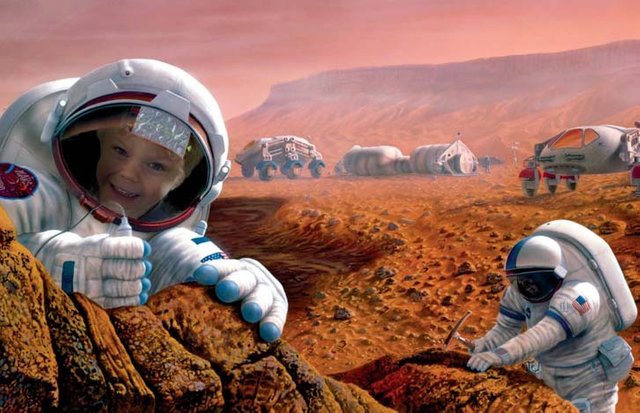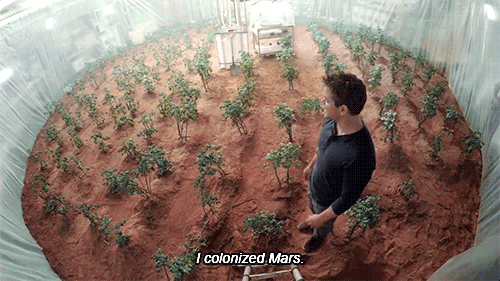Climbing Mt. Sharp: Reforging a Path for Human Space Travel
On a whim one morning, I showed my 3-year-old son NASA’s 2014 special issue on Mars. The content was way above Liam, of course, but the breathtaking illustrations were right at his level. I paged through the issue, pointing at pictures and explaining little things as I went.
Then I showed him the mosaic of photos Curiosity shot of Mount Sharp. “That is a big, big mountain!” Liam exclaimed. I told him that a robot named Curiosity was climbing all the way to the top of that mountain. Maybe he didn’t understand the part about the robot, or maybe he just got caught up in the idea of climbing. But he turned to me with big round eyes, pointed a hesitant finger to his chest, and said, “Me?!”

That, right there, is all the argument I’ll ever need for a human-crewed space program.
Don’t get me wrong: robots are super cool. They explore new vistas, perform chemistry experiments, and relay data we can’t get by ourselves just yet. The images captured by rovers and orbiters alike inspire the imagination. Still, there’s nothing quite like climbing that mountain yourself.
The question is, how do we get to that mountain? A 3-year-old can lend you unbridled optimism for the future, but reality always intrudes. After all, NASA has struggled for a clear goal ever since it reached the Moon. In a recent presentation to the American Astronomical Society, space historian and policy expert John Logsdon pondered that sense of drift as he described our current position between a rock and a hard place.
First, there’s the question of resources. President Kennedy’s 1961 directive to land a man on the Moon “before the decade is out” came with an immediate 89% increase in NASA’s budget. In the mid-1960s, the agency’s funding peaked at roughly 20% of all non-defense, discretionary spending. But during Nixon’s tenure, that percentage plummeted to 6%, and in this century it has remained between 3% and 5%.
Then there’s the question of destination. Low-Earth orbit was the only place humans went post-Apollo, though many hoped to press on to Mars sometime in the future. Presidents have also issued directives to establish a Moon colony or visit a near-Earth asteroid. But their budgets never backed those grand visions. So there’s our rock and our hard place: nobody wants to give up our ambitious goals, but we don’t have the financing to achieve them.
There are potential ways out of this tight spot, however. Logsdon argued that NASA, as a source of alternative funding, should refocus on international coalitions, challenging as they may be to establish and manage.
Another solution might be to combine NASA’s vision and technical prowess with commercial sensibilities. In the discussion following Logsdon’s talk, Martin Elvis (Harvard-Smithsonian Center for Astrophysics) suggested that private ventures such as those trying to develop space tourism or asteroid mining should help slash launch costs, a major expense of spaceflight, while NASA continues to reduce the technical risks.
Agree
Good Article
One word : One word teleprescense
Imagine a remotely controlled robot that is so well constructed that it can do anything that a person can do, except think.
Imagine that you attach sensors, actuators and other types of ors to your body such that as far as your senses are concerned you ARE the robot when you activate them.
Imagine all of the pros of manned exploration and none of the cons.
The only downside I can see is speed of light lag. Latency.
It would be easy to fund. If the US would kindly stop bombing other countries, boom, trillions of wasted money would be available.😀
Right... because money is the reason it hasn't happened yet.. eyeroll
Think is very important colonize the space, at least the near space. But another important thing it is not depend only of that. The human being is devastating earth so quickly. If we start to care the planet seriously we can have more decades to develop a safa way to colonize another planets. Some people spend a lot of resources. More than a spend is a dispend. I think that is very important. Teach people to care the planet. Starting by doing small things all days. For give an small example, refuse to receive plastic bags when is no truly needed. That thing help to generate less polution. Another thing we are doing is reconverting us energy sources to green energy. I am living in a third country world and i am doing that. Consume less and take more care of earth. Your article is excellent, I voted, commented and follow you. Have a nice weekend and enjoy the free time with family.
Would you like to cure cancer and eliminate hunger and have dogs and cats live together in harmony as well ?
I love and respect your post and thank you for the ideas we can make small changes like plastic bags, but I also feel we need to do more common sense and useful things on Earth before we talk about jet-setting off into the Stars of Space.
So I mean people here now on Earth and future generations will be better served if people do like you did and make simple practical sensible measurable suggestions. Until we start to make a positive impact to improve our lives on planet Earth; we might find Mars serves a better purpose as a missile test range than someplace humanity should be visiting.
Thank you for caring and trying to help the environment and planet Earth as well as future generations . . .
/ hugz ; )
this makes me think of that martian matt damon movie.. lol

Funny thing about humanity, we exist in a small region of space called the Habitat zone, or Goldilocks Zone. We must be close to a heat source such as the Sun, not to close; not to far away.
We need 2 gallons every day, clean air and a stable atmosphere; either natural or artificial around our skin. pH and gases ratios must be near perfect, protein, carbohydrates, fats, vitamins or minerals.
Plus humans need social connections and mental rewards and simulations. Simply humans for all our vast accomplishments on planet Earth are a very vulnerable and almost worthless species. To suggest humanity is anywhere near ready to travel to Mars is just pure fantasy. Sure we could do it; but reality says in today's modern world it takes 8 months to get a roadway pot hole filled.
People forget how long it took to get the international space station up and running. Remember it had Skylab and Mir to iron out most of the bugs. Today 99.999 % of people have less than zero interest in the International Space Station. To suggest people have any interest in sending a walking talking human to Mars is the heights of madness, people just do not care and see no useful reason to do such a thing.
Decades ago some very clever people created a Bioshpere two on planet Earth. This was a very very ambitious project and remarkably successful, but a few nasty people forced adverse publicity to shut it down. This marvelous experiment was never given a chance to succeed and any planned mission to Mars has absolutely no useful outcomes for society.
Thus a mission to Mars would have to be privately funded and that will happen just after automobile companies start giving away free cars. Sure it might be nice to visit Mars up close and personal, however reality says only two human beings have visited the very deepest ocean floor beds, just two people.
Humanity has millions of miles of rain forests and ocean depths to explore in the name science, medicine, technology and biology; why would any rational person think visiting a worthless hunk of cast off space rock would be worth spending Gold on ?
Sure Mars is out there, so is the demoted dwarf-planet; renamed as plutoid's. Pluto was a real planet until it was sacked in a reshuffle of scientific bureaucracy. So yes Mars is there, so is Pluto; yet no one talks about visiting poor little Pluto; yes it is a long long way away. But given today's technology Mars is almost as unreachable as Pluto.
/ hugz ; )